Anchoring a corner spot in the historic district along Hilo Bay, the Mokupapapa Center is where Hawaiian cultural and environmental education converge, the history and ecology of the islands told through interactive exhibits and engaging presentations. Celebrating its 20th anniversary this year, the center has always had a mission of being a gateway to the isolated northwestern region of the Hawaiian island chain, where nature thrives away from the reach of modern society.
Among extensive coral reefs, seemingly bottomless waters, and sheltered atolls, the biological diversity in this area of the Pacific Ocean is unparalleled – and although it’s difficult to visit the far-flung islands in person, Mokupapapa is your ticket to explore this magnificent and untouched region of the Hawaiian archipelago.
Our Big Island bed and breakfast is just a 45-minute drive from downtown Hilo, so plan your visit to the Mokupapapa Center, a fun mix of oceanic education and entertainment for the whole family.

Hawaii’s Origin – Millions of Years of History, Celebrated as A National Monument and Unesco World Heritage Site
Hawaii’s far northwestern stretch of 10 main islands and smaller atolls holds a rare and extraordinary significance, as it’s believed to be the ancestral, cosmic home of all Hawaiians. Compared to the Big Island – the youngest of all the Hawaiian islands and still erupting in real time – this 1,350-mile region includes the oldest Hawaiian isles, formed over 28 million years. Hawaiians trace their origin story to these ancient islands, believing it’s the place where all life begins and where we return to after death.
According to the Hawaiian folklore, “Earth mother” and “sky father” convene here, giving rise to “Aina Momona,” or a place of abundance – fourteen million seabirds nest and thrive along the protected atolls, along with green sea turtles and Hawaiian monk seals, while 3.5 million acres of coral reef support one of the most biologically diverse collections of fish found in any ocean (a staggering 90,000 fish species are endemic, found here and nowhere else).
Due to its essential role in Hawaiian culture and its ecological significance, the 582,000 square mile region was awarded National Monument status in 2006 (its name, Papahanaumokuakea, combines the Hawaiian words for earth mother and sky father, embodying the creation story). A few years later, in 2010, it became a UNESCO World Heritage Site, the second recognized site in Hawaii (the first is Volcanoes National Park, located just a few minutes from your Volcano Village rainforest bungalow). The scope and size of the national monument are genuinely astonishing, making up the vastest marine conservation area on the planet and encompassing an area larger than all the other national parks combined!

Spending an Afternoon at the Mokupapapa Center – A 3,500-gallon Fish Tank, Fascinating Displays, and Interactive Exhibits
After the leisurely 30-mile drive from Volcano Village to Hilo, start the morning with some delicious coffee at Big Island Coffee Roasters, one of our favorite local purveyors of legendary Kona coffee and just a few blocks from the Mokupapapa Center on Kamehameha Ave. Head over to the Mokupapapa Center, which is open Tuesdays through Saturdays and is free to visit. The national science agency, NOAA, funds their research and outreach, seeing the importance and value of making the educational hub accessible to all.
Once inside the center, every wall has a different exhibit, whether it be a cosmic mural illustrating the Hawaiian creation myth tied to these islands, displays showing the massive Laysan albatross seabird (one of several rare birds that nest on the remote shores of these islands), or exhibits on endangered green sea turtles. Walk up the beautiful stairway (made of native Hawaiian koa wood) to the second floor, where you can see the double-hulled sailing canoes that Hawaiian seafaring explorers have used since first setting sail from Polynesia and settling the islands. Today, Hawaiians still head out on the waters in these traditional vessels, navigating to the northern reaches of the Hawaiian island chain without any modern wayfinding technology, keeping a connection with their cultural roots.
One of the highlights is the indoor saltwater fish tank, where you can see textured coral up close and several types of endemic reef fish only found in the millions of acres of coral reef surrounding the northwestern Hawaiian atolls. From shallow reefs to waters at depths of over 15,000 feet, gigantic fish like giant trevally and several predatory sharks rule the underwater roost. Displays show teeth from great whites, who still flourish today, and megalodons, a now-extinct shark species thought to be 60 feet long (with terrifyingly large teeth to match) that swam these waters when the first Hawaiian islands came into being millions of years ago.
Maritime Preservation – Honoring the Past and Looking Ahead to the Future
The Mokupapapa Center has an equal focus on the past and the future, looking back for historical reference and gazing ahead with an eye on ecological conservation. The national monument’s unique status as the origin point of the entire Hawaiian island chain gives us great insight into plate tectonics and volcanic formation. Meanwhile, its isolated location provides a rare glimpse into how fish and animal species survive in an environment untouched by tourism and development. Relics from more modern history also include shipwrecks dating back to when whaling vessels commanded the seas and Japanese and American ships that met their end here during World War II. The USS Macaw naval ship has a particularly intriguing story, as it sank in 1944 while trying to rescue a Navy submarine – today, divers still swim down to the sunken wreckage some 80 years after the war ended.
You’ll come away from the center inspired, seeing their devoted efforts to preserve the island ecosystem for future generations. With global warming and increasing seawater temperature posing a real threat to sealife here, sophisticated underwater mapping allows scientists to accurately track where the coral reef is most at risk, guiding their efforts to fight against coral bleaching and diminishing algae diversity. Throughout the center, you’ll also see “conservation art” created by local artists using recycled trash recovered from the coral reefs within the monument – it’s a potent symbol of transforming our waste in an act of artistic renewal, beckoning back to the Hawaiian creation myth that gave rise to the islands so long ago.
Mokupāpapa Discovery Center
76 Kamehameha Avenue
Hilo, Hawaiʻi 96720
Phone: 808-498-4709
Stay with us and explore Hawaii’s ancient culture, remarkable ecology, and oceanic beauty at the Mokupapapa Center!

